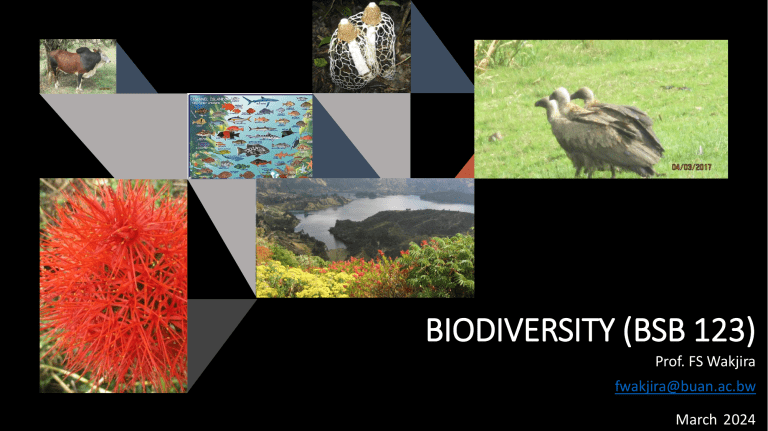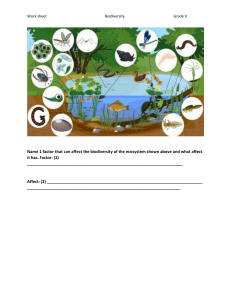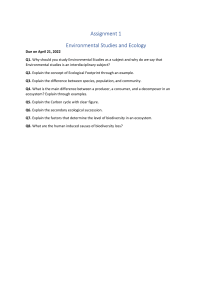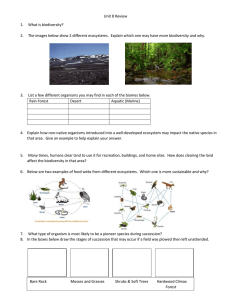
BIODIVERSITY (BSB 123) Prof. FS Wakjira fwakjira@buan.ac.bw March 2024 BSB123 Biodiversity course outline Study the Course Outline (eduhub) The course is divided into five sections I. Evolution and Taxonomy (Prof FS Wakjira) II. Diversity of prokaryote, Protoctista and fungi (Microbiology) (Mrs M Batlhophi) III. Plant diversity (Dr T Selebatso) IV. Animal diversity (Prof SW Makhabu) V. Ecology (Prof Makhabu) [2WKs the rest each 3WKs] Ask any questions All sections have practical sessions • Week 1. Lab Induction • Recap about lab protocols and regulations Evolution and Taxonomy • Week 2: Evolution • Geological timeline activity • Mechanisms of evolution • Week 3: Taxonomy • Identification of organisms using keys • Tutorial session will start next week! Modes of assessment Course assessment: • Continuous assessment (CA) 50%: Exam 50% • Continuous Assessment shall comprise the following: • (a) Two theory tests and two practical tests • Theory tests = 30% • Practical tests = 40% • Theory Tests dates: • Test 1: 23/04/2024 • Test 2: 28/05/2024 • (b) Online quizzes = 10% • (c) Laboratory reports = 20% Check course outline for partical Tests dates Expectations Write down your expectations (4 or 5 points) Objectives of the course • By the end of the course, you should be able to: • Understand evolutionary basis of biodiversity and recognize the value of taxonomy. • Identify and describe living organisms, their classification and evolutionary relationships. • Explain the three domains and the five- kingdom classification system. • Discuss forms and functions of living organisms. • Examine interrelationships among the organisms and their abiotic environment. • Define some taxonomic and evolutionary terminology. • Appreciate agricultural ecology. What is Biodiversity? Objectives • In this lecture we shall talk about: • Definition and concept of Biodiversity • Value of Biodiversity • Threats to Biodiversity • Biodiversity conservation Understanding Biodiversity Conservation Biodiversity loss Explore and use Classifying (naming) and describing Understanding the dynamics and their relationships How did biodiversity evolve? What is biodiversity? Via Evolution! Life on earth are related/connected Diversity of life forms! Life on Earth have great diversity What is biodiversity? • The term biodiversity was first coined by Edward O. Wilson in 1986 • Biodiversity is a short form of Biological Diversity • Bio – living organisms/life • Diversity – variability • Living things: all the organisms descended from a single-celled ancestor. • Biodiversity • the variability among living organisms from all sources including, inter alia, terrestrial, marine and other aquatic ecosystems and the ecological complexes of which they are part (CBD definition) • It is the degree of variation of life forms within an ecosystem or entire planet Biodiversity has three components • Diversity within species, between species and of ecosystems Ecosystem diversity Species diversity Genetic diversity • What is genetic diversity? • It describes the variation in the number and types of genes as well as chromosomes present in different species. • It refers to the diversity (or genetic variability) within species • The magnitude of variation in genes of a species increases with increase in size and environmental parameters of the habitat. • Each individual species possesses genes which are the source of its own unique features: • In human beings, for example, the huge variety of people's faces reflects each person's genetic individuality. • Genetic diversity has the following importance: • It helps in speciation or evolution of new species; • It is useful in adaptation to changes in environmental conditions; • It is important for agricultural productivity and development. What is Species diversity? It is defined as the number of species and abundance of each species that live in a particular location. The number of species that live in a certain location is called species richness. No. of plant species per ha No. of animal species per ha No. of cows per ha The richness of a species tells about the extent of biodiversity of a site and provides a means for comparing different sites. The species richness depends largely on climatic conditions. When a species is confined entirely to a particular area, it is termed as endemic species. No. of plant species in Botswana Number of bird species in Botswana • How many species do you think exist on Earth? • There are approximately 1.8 million different species classified on Earth (~1 million are insects) • New species are being discovered each year. • Scientists estimate that there may be between 5 to 100 million species that actually live on Earth. • These diversity are the product of nearly 4 billion years of evolution • Each year, approximately 13,000 more species are described. • The hottest spots for species diversity are tropical rainforests. • Tropical rainforests comprise only 7% of all land on Earth yet are home to nearly 50% of all the species on Earth. • What is ecosystem diversity? • It refers to the diversity of ecosystems in a particular geographic location. • An ecosystem is, in turn, a system that includes all living organisms (biotic factors) and the physical environment (abiotic factors) functioning together as a unit. • Ecosystems may be terrestrial, freshwater, marine, and artificial Patterns of biodiversity distribution: global, regional & local Biodiversity unequal distributed in space and time Some areas highly diverse and some areas poorly diverse Below maps show patterns of global distribution of some groups of organisms https://biodiversitymapping.org/ Pattern of distribution: at microsite level Why such biodiversity variation across space? Regional geological history Environmental factors (e.g., climate, topography, edaphic factors) Ecosystem productivity (more solar energy, water availability, and a relatively constant and predictable environment Habitat heterogeneity and suitability, Competition Predation Land use history and human factor Etc Why should we care for biodiversity? WE depends on biodiversity for our existence Life on earth depend on biodiversity Source: Millennium Ecosystem Assessment Values of Biodiversity There are direct and indirect benefits of biodiversity ⚫ Direct economic value - Humans depends on biodiversity for food, clothing, energy, medicine and shelter ⚫ Environmental regulation – prevent erosion, purify water, recycle CO2 – regulate climate, recycle nutrients through decomposition ⚫ Psychological value – direct or indirect enjoyment with nature ⚫ Intrinsic value – independent of humans/ they have the right to live Agricultural: Of 80,000 known edible plants on the planet, we depend on 20 species to provide 90% of global food supply. Corn, rice and wheat are 50% alone! They are huge potential for future food sources Medicinal Medicinal: 40% of modern medicines come from plants/animals/fungi, 95% of known plant species have never been tested for medicinal value Huge potential for future drug development The benefits and services provided by biodiversity include: Maintenance of soil quality Maintenance of air quality Maintenance of water quality Pest control and mitigation of natural disasters Detoxification and decomposition of wastes Pollination Crop production Provision of food security Provision of health care – medicines Income generation Spiritual and cultural value Climate regulation Threats to Biodiversity? Despite their importance, biodiversity loss has become a significant issue for scientists and policy-makers recently Species are becoming extinct at the fastest rate known in geological history and most of these extinctions have been tied to human activity Habitat loss and fragmentation Introduction of exotic species Over-exploitation Pollution Global climate change Change in ecosystem composition Habita fragmentation Entact ecosystem Urbanization Conversion Pollution Overexploitation Current extinction rates are unusually high Source: Millennium Ecosystem Assessment What is biodiversity conservation? • Maintaining the diversity of species, habitats, and the interrelationships between organisms and the environment to keep ecosystems healthy and functioning. Conservation is defined as management of human use of biodiversity so that it may yield sustainable benefit to the present generation while maintaining its potential to meet the needs and aspirations of future generations. There are two basic strategies of biodiversity conservation In-situ (on site) and Protected Area Systems National Parks Biosphere reserves Ex-situ (off site) Seed banks Gene banks Botanical Gardens Zoological gardens Sperm/egg banks Frozen embryos Ex-situ conservation It is defined as “the conservation of component of biological diversity (Sample of genetic diversity, particularly of endangered species) outside their natural habitats”. It involves maintenance and breeding of endangered plant and animal species under partially or wholly controlled conditions. E.g., Zoos, Botanical Gardens, Aquaria, Nurseries, DNA bank, Seed bank, Gene bank etc. Storage of tissues, seeds, pollen, semen, ovules, embryos, microbial cultures, DNA There are more than 1500 Botanical gardens in the world containing more than 80,000 species. There are more than 800 zoos around the world with about 3,000 species of mammals, birds, reptiles and amphibians Provides “insurance policy” and can play important role in recovery programs. In-situ conservation It simply means conservation of species in its natural ecosystem or even in manmade ecosystems. This strategy emphasizes protection of total ecosystem through a network of “protected area”. Protected Areas: an area of land and / or sea specially dedicated to the protection and maintenance of biological diversity and managed through legal effective means. There are different categories of protected areas which are managed with different objectives. These include; Biosphere reserves ,National parks, Wildlife Sanctuaries etc. Setting Priorities for Biodiversity Conservation It is impossible to actively conserve all species/ecosystem because of limited time and money. As a result, we must make decisions about how to target conservation efforts and limited resources can have the greatest impact. So, how do we decide? Setting priorities species/areas What is the Goal of Conservation? Conservation efforts focus on protecting entire ecosystems as well as single species. Protecting an ecosystem will ensure that the natural habitats and the interactions of many different species are preserved at the same time. Conservation Challenges Protecting resources for the future can require people to change the way they earn their living today. Conservation regulations must be informed by solid research and must try to maximize benefits while minimizing economic costs. How to measure biodiversity? Biodiversity can be quantified in many ways. Genetic diversity Two main factors considered by ecologists for measuring species diversity: Species richness Species evenness Ecosystem/habitat diversity Functional diversity Structural diversity Different types indices (indexes) are used to analysis





